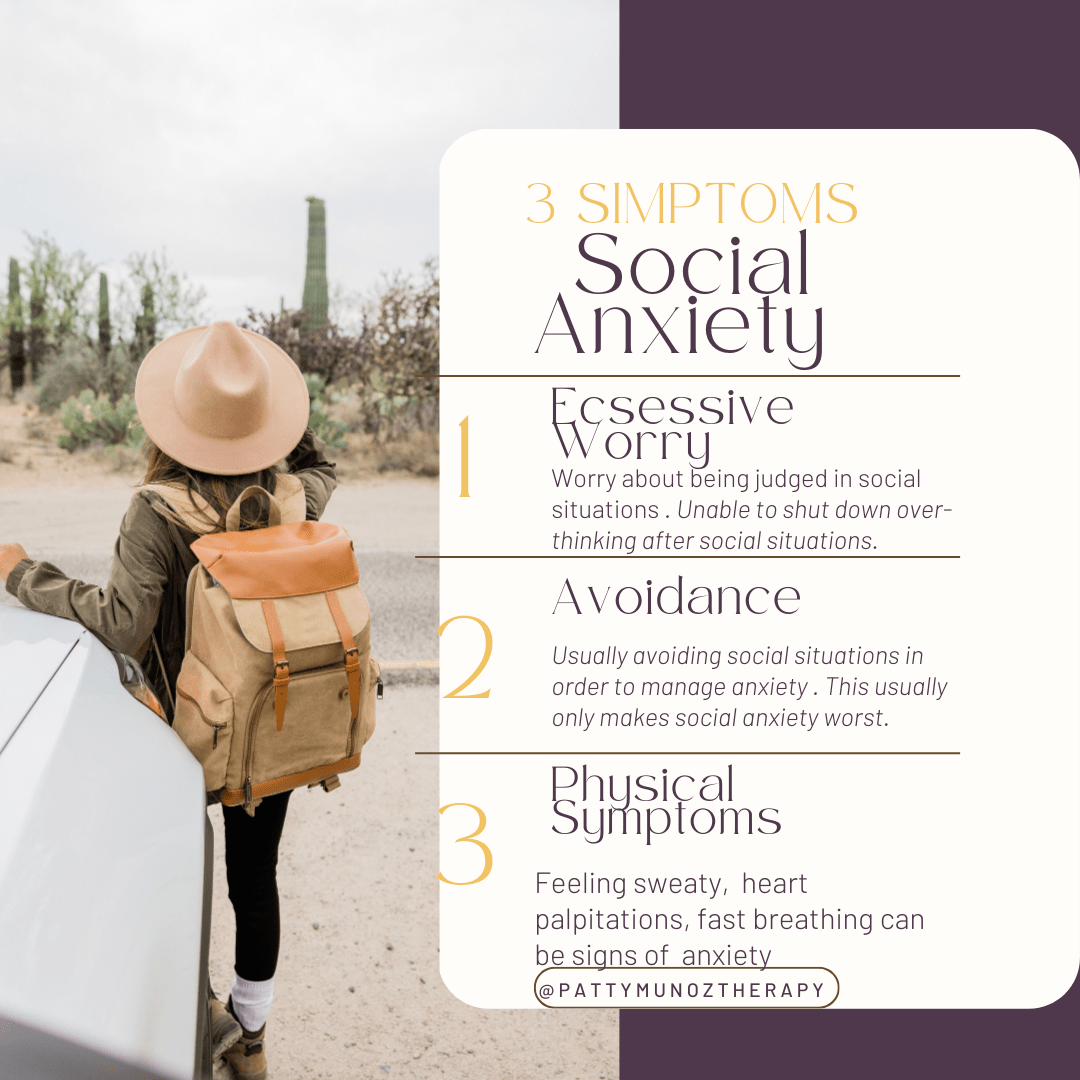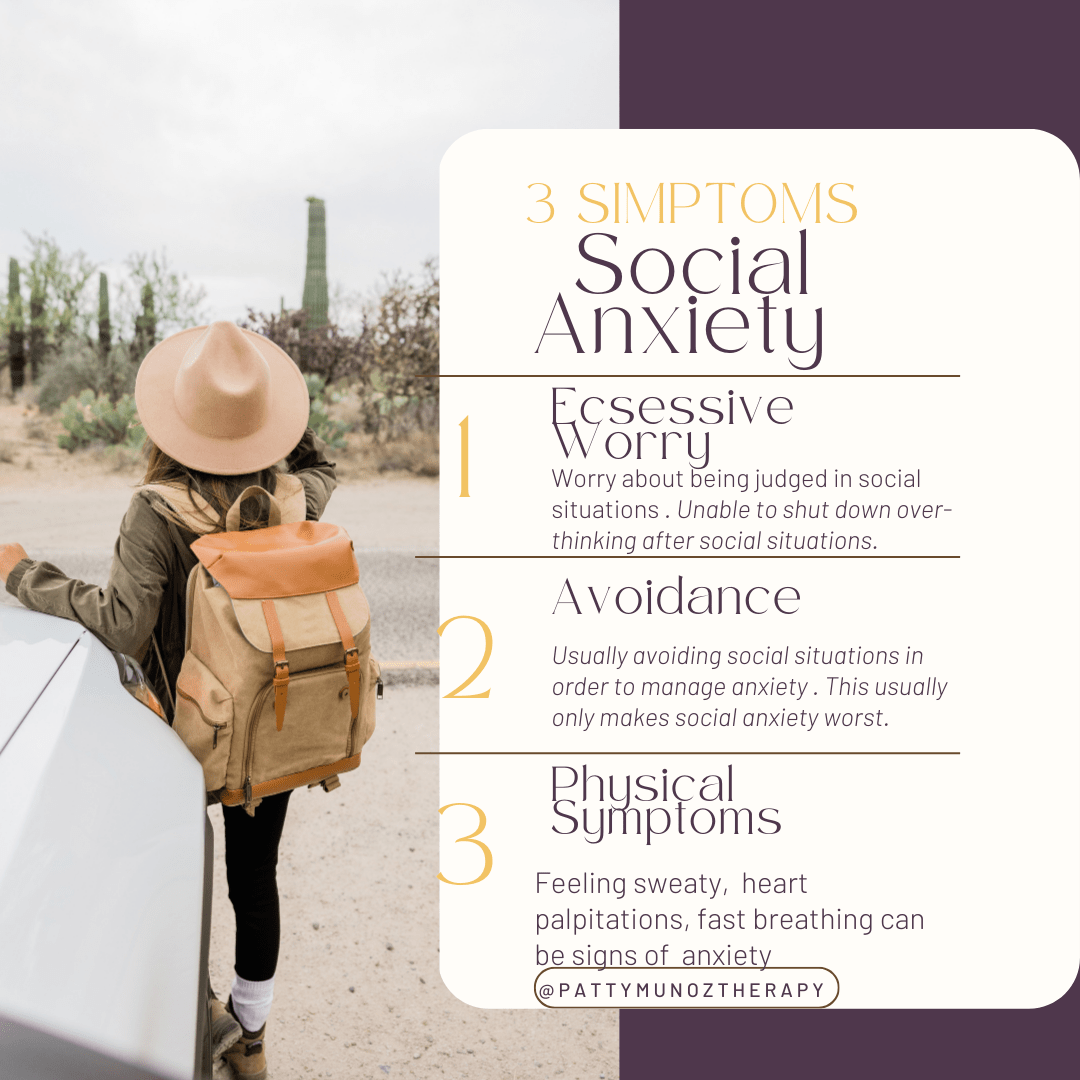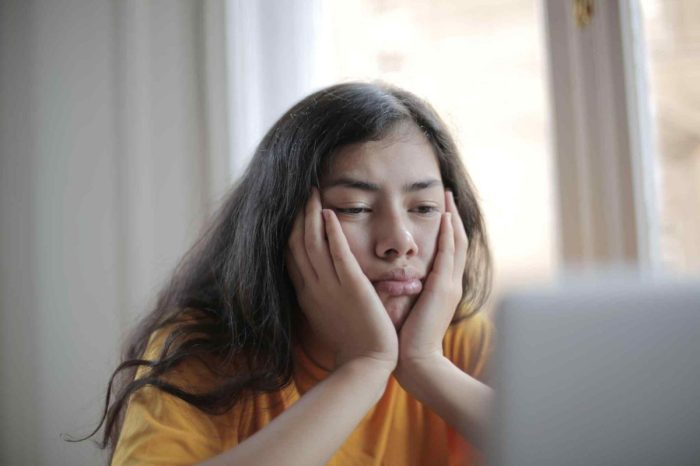Symptoms of social anxiety can manifest in a variety of ways, impacting individuals differently. This exploration delves into the common physical, emotional, and cognitive responses to social situations, from mild discomfort to severe distress. We’ll examine how different social settings trigger varying levels of anxiety, and how these reactions are influenced by personal factors and demographics. Understanding the spectrum of symptoms is crucial for recognizing and addressing social anxiety.
This comprehensive guide will explore the diverse ways social anxiety presents itself, from avoidance behaviors and self-sabotaging tendencies to the impact on daily life, relationships, and career choices. We’ll also examine how symptoms can vary across demographics and discuss the importance of professional support in managing this condition.
Defining Social Anxiety Symptoms
Social anxiety disorder, a prevalent mental health condition, manifests in a range of physical, emotional, and cognitive responses to social situations. Understanding these symptoms is crucial for recognizing the condition and seeking appropriate support. Individuals experiencing social anxiety often find themselves overwhelmed by anticipatory worry and fear, leading to avoidance behaviors and a significant impact on daily life.Recognizing the nuanced interplay between these symptoms is key to effective intervention and management strategies.
By understanding the diverse expressions of social anxiety, we can better equip individuals to navigate challenging social encounters and cultivate a greater sense of well-being.
Physical Symptoms of Social Anxiety
Physical symptoms often accompany social anxiety, creating a heightened sense of discomfort and distress. These physical sensations can range from mild to severe, impacting an individual’s ability to participate fully in social interactions. Common physical manifestations include rapid heartbeat, sweating, trembling, and shortness of breath. These responses are often triggered by the anticipation of social situations or during the actual encounter.
- Rapid heartbeat: A racing pulse, often perceived as pounding or fluttering, is a common physical response to social anxiety. This heightened heart rate can contribute to feelings of panic and overwhelm.
- Sweating: Excessive sweating, particularly in the palms of the hands or on the forehead, is another frequent physical symptom. This physiological reaction can be triggered by the perceived scrutiny of others or the anticipation of social judgment.
- Trembling: Shaking or trembling, which can affect the hands, legs, or the entire body, is a common manifestation of physical anxiety. This involuntary movement can disrupt one’s ability to perform tasks or maintain composure during social interactions.
- Shortness of breath: Difficulty breathing, characterized by feelings of tightness in the chest or a sensation of not getting enough air, is a significant physical symptom. This can lead to feelings of panic and exacerbate the anxiety.
- Nausea or stomach upset: Discomfort in the stomach, including nausea, vomiting, or digestive issues, can also be associated with social anxiety. These symptoms are often linked to the physiological stress response triggered by social situations.
Emotional Responses in Social Anxiety
Emotional responses in social anxiety are multifaceted and can range from mild apprehension to intense fear and panic. These emotions often accompany the physical symptoms and contribute to the overall experience of social anxiety. Individuals may experience a wide range of emotions, including fear of judgment, embarrassment, and a strong desire to avoid social situations.
- Fear of judgment: A pervasive fear of being negatively evaluated or judged by others is a central component of social anxiety. This fear can manifest in a variety of ways, including worries about making mistakes, appearing foolish, or not meeting social expectations.
- Self-consciousness: An intense focus on oneself and one’s perceived flaws or imperfections during social interactions is a frequent emotional response. This self-consciousness can lead to feelings of inadequacy and embarrassment.
- Embarrassment: The anticipation or experience of feeling embarrassed or humiliated in social situations is a significant emotional component of social anxiety. This feeling can be triggered by a perceived social faux pas or a fear of being scrutinized by others.
- Panic attacks: In severe cases, social anxiety can lead to panic attacks, characterized by intense fear, rapid heartbeat, shortness of breath, and a sense of impending doom. These attacks can occur during or in anticipation of social interactions.
Cognitive Distortions in Social Anxiety
Cognitive distortions are biased and inaccurate thought patterns that contribute to and maintain social anxiety. These distortions often lead to negative self-perceptions and an exaggerated interpretation of social situations. They can significantly influence the emotional and behavioral responses to social situations.
- Catastrophizing: Expecting the worst possible outcome in social situations, even if unlikely, is a common cognitive distortion. This tendency to exaggerate negative possibilities can significantly heighten anxiety.
- Overgeneralization: Drawing broad conclusions about oneself based on a single negative social experience is a common cognitive distortion. This can lead to a sense of inadequacy and a fear of future social encounters.
- Mind reading: Assuming that others are negatively judging or evaluating oneself without evidence is another common cognitive distortion. This can lead to feelings of isolation and a reluctance to engage in social interactions.
Comparison of Social Anxiety Levels
| Symptom Level | Physical Symptoms | Emotional Responses | Cognitive Distortions |
|---|---|---|---|
| Mild | Occasional blushing, slight sweating, mild discomfort. | Mild apprehension, self-consciousness, occasional nervousness. | Minor negative self-talk, selective attention to negative aspects. |
| Moderate | Increased sweating, trembling, rapid heartbeat, difficulty breathing. | Significant anxiety, fear of judgment, feelings of inadequacy, potential for panic attacks. | Overgeneralization, catastrophizing, exaggerated sense of social scrutiny. |
| Severe | Severe sweating, trembling, nausea, difficulty breathing, panic attacks. | Intense fear, overwhelming anxiety, significant avoidance of social situations, feelings of dread. | Absolute certainty of negative outcomes, pervasive negative self-talk, distorted perceptions of social interactions. |
Specific Social Situations and Triggers
Social anxiety isn’t a uniform experience; its intensity and manifestation vary significantly depending on the specific social situation. Understanding these triggers is crucial for managing the anxiety and developing coping mechanisms. Recognizing the patterns in your own anxieties can empower you to navigate challenging social encounters more effectively.The severity of social anxiety symptoms can fluctuate dramatically across different social settings.
Factors such as the perceived level of scrutiny, the presence of authority figures, or the familiarity of the environment all play a role in shaping the intensity of the anxiety response. Some individuals might feel overwhelmed in large, unfamiliar groups, while others might experience more pronounced discomfort during one-on-one interactions.
Common Social Situations That Trigger Anxiety
Different social situations can evoke varying degrees of anxiety. Understanding these situations and the potential triggers helps in developing strategies to cope with them. Individuals experiencing social anxiety often find themselves experiencing a heightened sense of self-consciousness in certain contexts.
- Public Speaking: The fear of public speaking is a prevalent social anxiety trigger. The perceived judgment from the audience, the pressure to perform flawlessly, and the fear of making mistakes are significant contributors to anxiety. This fear can manifest in physical symptoms like trembling, sweating, and a racing heart, as well as psychological distress.
- Meeting New People: Encountering unfamiliar individuals can be stressful for those with social anxiety. The fear of being judged, the anticipation of awkward silences, and the pressure to create a positive first impression contribute to the anxiety response. This situation can evoke significant distress, often leading to avoidance behavior.
- Social Gatherings: Large social gatherings, like parties or celebrations, often heighten social anxiety. The vast number of unfamiliar individuals, the potential for uncomfortable interactions, and the pressure to maintain a social facade contribute to the anxiety. The feeling of being scrutinized and the need to constantly monitor one’s behavior can be incredibly overwhelming.
- One-on-One Interactions: While not always a trigger, one-on-one interactions can sometimes be challenging. The fear of not saying the right things, the apprehension about being judged, and the anticipation of potential conflict can lead to anxiety. This situation might be particularly triggering for those who struggle with perceived social shortcomings.
Factors Influencing Anxiety Intensity
Several factors contribute to the intensity of the anxiety response in social situations. Recognizing these factors can help individuals better understand and manage their anxiety.
- Perceived Level of Scrutiny: The perceived degree of observation from others significantly impacts the intensity of the anxiety. If an individual feels they are being closely watched or judged, their anxiety is likely to be higher. The feeling of being under constant evaluation can heighten feelings of vulnerability.
- Presence of Authority Figures: Interactions with authority figures, like teachers, bosses, or police officers, can be especially anxiety-provoking for individuals with social anxiety. The fear of making a mistake, the apprehension about potential negative consequences, and the feeling of being judged by a person in a position of power can amplify anxiety.
- Familiarity of the Environment: The familiarity of the social setting plays a role in the anxiety response. Unfamiliar environments or situations often evoke more intense anxiety due to the lack of control and predictability. The feeling of being lost or out of place can be a significant source of distress.
Examples of Social Situations and Anxiety Levels
The intensity of anxiety varies considerably across different social situations.
| Social Situation | Potential Symptoms | Approximate Anxiety Level (1-10, 10 being highest) |
|---|---|---|
| Public speaking | Sweating, trembling, rapid heart rate, fear of making mistakes | 7-9 |
| Meeting new people | Nervousness, difficulty initiating conversations, fear of being judged | 6-8 |
| Social gatherings | Overwhelm, difficulty engaging in conversation, feeling self-conscious | 5-7 |
| One-on-one interactions with a stranger | Shyness, difficulty maintaining eye contact, fear of appearing awkward | 4-6 |
Behavioral Manifestations
Social anxiety isn’t just about feeling anxious; it significantly impacts how we behave in social situations. Understanding these behavioral manifestations is crucial for recognizing and addressing social anxiety. These behaviors often stem from a fear of negative judgment and evaluation, leading to avoidance and self-sabotaging patterns. Recognizing these patterns is the first step toward developing coping mechanisms and healthier interactions.
Avoidance Behaviors
Social anxiety often manifests as a strong desire to avoid social situations. This avoidance can range from minor discomfort to complete withdrawal. Individuals may actively avoid parties, social gatherings, or even everyday interactions like conversations with colleagues. Avoiding potentially anxiety-provoking situations might seem like a simple coping mechanism, but it can lead to a cycle of isolation and hinder the development of essential social skills.
This avoidance can severely limit opportunities for personal growth and social connection.
Self-Sabotaging Behaviors
Individuals with social anxiety may engage in behaviors that inadvertently undermine their social interactions. This can manifest in various ways, from making excuses to avoid commitments, to prematurely ending conversations, or even choosing to withdraw from group activities. Such self-sabotaging behaviors are often unconscious attempts to protect themselves from perceived negative outcomes, but they ultimately reinforce the cycle of anxiety.
This self-imposed isolation can create a sense of inadequacy and further fuel social anxiety. For example, someone might consistently arrive late to social events, or offer overly-apologetic explanations for their actions.
Coping Mechanisms
Individuals often employ various coping mechanisms to manage anxiety in social contexts. These mechanisms can range from relatively healthy approaches to maladaptive ones. Some common coping mechanisms include minimizing eye contact, avoiding conversations, or using alcohol or drugs to temporarily suppress anxiety. While some coping mechanisms might offer temporary relief, they may not address the underlying cause of the anxiety and can even exacerbate the problem in the long run.
Identifying and understanding these mechanisms is key to developing more effective strategies for managing social anxiety.
Observable Behaviors Signaling Social Anxiety
Observing specific behaviors can help identify individuals experiencing social anxiety. These behaviors can be subtle or overt, but they consistently point to underlying anxiety. These include fidgeting, sweating, rapid heart rate, avoidance of eye contact, and difficulty initiating or maintaining conversations. They also often display a heightened sensitivity to criticism or judgment, often appearing overly apologetic or self-deprecating.
Table of Behavioral Responses to Social Anxiety Triggers
| Social Anxiety Trigger | Potential Behavioral Response |
|---|---|
| Public speaking | Avoiding eye contact, stuttering, rapid speech, profuse sweating, physical trembling, and an urge to leave the situation. |
| Meeting new people | Minimizing interactions, avoiding conversations, and staying in the background. |
| Large social gatherings | Seeking out quiet corners, feeling overwhelmed, and leaving early. |
| One-on-one conversations | Difficulty initiating conversation, speaking softly, or abruptly ending conversations. |
| Being the center of attention | Becoming withdrawn, avoiding eye contact, and trying to disappear from the scene. |
Impact on Daily Life
Social anxiety isn’t just a feeling; it’s a force that significantly impacts various aspects of daily life, shaping routines, relationships, and career paths. The constant fear of judgment and social scrutiny can lead to avoidance behaviors, impacting everything from simple interactions to major life decisions. Understanding these impacts is crucial for recognizing and addressing the challenges faced by individuals struggling with social anxiety.
Daily Routine and Activities
Social anxiety often manifests in avoidance behaviors, leading to a restrictive daily routine. Individuals may avoid social gatherings, public places, or even simple tasks like ordering food at a restaurant or using public transportation. This can lead to a diminished quality of life, as opportunities for personal growth and exploration are missed. For instance, someone with severe social anxiety might skip a friend’s birthday party, a company outing, or even avoid going to the gym because of the perceived social interaction involved.
Career Choices and Professional Development
Social anxiety can significantly influence career choices. Individuals might opt for careers that require minimal social interaction, potentially limiting their professional growth and earning potential. Presenting ideas or collaborating with colleagues can be especially challenging, affecting promotion opportunities and hindering professional development. This can lead to feelings of inadequacy and a sense of being trapped in a role that doesn’t fully utilize their skills and abilities.
For example, a highly skilled software engineer might choose a role that involves minimal client interaction, sacrificing career advancement opportunities.
Maintaining Relationships
Social anxiety can create considerable challenges in maintaining healthy relationships. The fear of judgment and the difficulty in expressing needs or feelings can lead to misunderstandings and conflicts. Maintaining friendships and romantic relationships can be especially difficult, as open communication and social engagement are essential components of strong bonds. This can result in strained relationships, feelings of isolation, and decreased overall well-being.
Academic Performance
The fear of public speaking, participating in class discussions, or interacting with peers can severely impact academic performance. Students might avoid asking questions, completing group projects, or even attending lectures, leading to feelings of inadequacy and academic struggles. This can lead to lower grades, increased stress, and difficulty navigating the educational environment.
Impact on Personal and Professional Life
| Aspect of Life | Impact of Social Anxiety |
|---|---|
| Daily Routines | Avoidance of social interactions, limited participation in activities, restricted access to public places, reduced quality of life. |
| Career Choices | Preference for solitary roles, missed opportunities for professional development, reduced career advancement potential, potential limitations in earnings. |
| Relationships | Difficulty in expressing needs and feelings, potential for misunderstandings and conflicts, strained or damaged relationships, increased feelings of isolation, reduced well-being. |
| Academic Performance | Avoidance of class participation, difficulty in completing group projects, reduced engagement in learning, lower grades, increased stress, and challenges in navigating the educational environment. |
Differences Across Demographics

Social anxiety, while a universal human experience, manifests differently across various demographics. Understanding these variations is crucial for accurate diagnosis and effective treatment. This exploration delves into how age, gender, culture, and socioeconomic status shape the experience of social anxiety. It highlights the importance of recognizing that the same underlying issue can present in diverse ways, requiring tailored approaches to support.
Feeling overwhelmed in social situations? That’s a common symptom of social anxiety. It can manifest in various ways, from sweaty palms to a racing heart. Luckily, mastering financial wellness can indirectly ease these anxieties. Learning smart credit card strategies, like the ones in this article about 7 brilliant credit card tricks save your money , can free up mental space and reduce stress.
This can significantly impact your overall well-being, ultimately reducing the symptoms of social anxiety.
Age-Related Variations
Age significantly influences the expression of social anxiety. Children and adolescents often exhibit social anxiety through shyness, avoidance of social situations, and difficulty interacting with peers. They might struggle with making friends, participating in class, or performing in front of others. As individuals transition into adulthood, the symptoms may evolve, potentially leading to more complex manifestations such as performance anxiety, social phobia, or difficulty maintaining relationships.
For example, a teenager might avoid school events, whereas a young adult might avoid job interviews or social gatherings.
Gender-Specific Considerations
While social anxiety can affect individuals of all genders, some studies suggest potential differences in symptom presentation. Women may experience social anxiety more frequently and report more intense emotional distress related to social situations. Symptoms might include increased feelings of self-consciousness, heightened sensitivity to criticism, and difficulty maintaining eye contact. Conversely, men might express social anxiety more through physical symptoms like blushing, sweating, or trembling.
These differences, however, are not universal and are likely influenced by cultural and societal expectations.
Cultural Influences
Culture plays a pivotal role in shaping the experience of social anxiety. Different cultures have varying norms regarding social interaction, emotional expression, and personal space. For instance, in some cultures, direct eye contact is considered a sign of respect, while in others, it might be perceived as confrontational or aggressive. These cultural nuances can impact the interpretation and expression of anxiety symptoms.
Individuals from collectivist cultures might experience social anxiety differently than those from individualistic cultures, as their values and social expectations differ.
Socioeconomic Status and Social Anxiety, Symptoms of social anxiety
Socioeconomic status (SES) can influence the development and manifestation of social anxiety. Individuals from lower socioeconomic backgrounds may face unique stressors like financial insecurity, limited access to resources, and social isolation. These stressors can contribute to anxiety symptoms. Conversely, individuals from higher socioeconomic backgrounds may face pressures related to maintaining social status, achieving success, and navigating complex social dynamics.
The impact of SES on social anxiety is complex and multifaceted.
Comparison Across Demographics
| Demographic | Symptoms | Potential Triggers | Impact |
|---|---|---|---|
| Children (6-12) | Shyness, difficulty interacting with peers, avoidance of social situations, clinging to caregivers. | New social environments, public speaking, performance situations, peer pressure. | Difficulty making friends, poor academic performance, decreased self-esteem. |
| Adolescents (13-19) | Social isolation, fear of judgment, self-consciousness, avoidance of social situations, performance anxiety. | School, social media, peer groups, romantic relationships, public speaking. | Difficulties in relationships, decreased participation in school activities, increased feelings of isolation. |
| Adults | Fear of judgment, avoidance of social situations, difficulty maintaining relationships, physical symptoms (sweating, trembling). | Job interviews, social gatherings, public speaking, romantic encounters. | Difficulty in career advancement, limited social interactions, decreased self-confidence, and relationship issues. |
| Women | Increased emotional distress, self-consciousness, difficulty maintaining eye contact, and hypersensitivity to criticism. | Social interactions, criticism from others, performance situations, and fear of inadequacy. | Increased risk of depression, relationship issues, and career limitations. |
| Men | Physical symptoms (blushing, sweating, trembling), avoidance of social situations, difficulty initiating conversations. | Social interactions, public speaking, job interviews, and fear of embarrassment. | Difficulties in maintaining relationships, limited career advancement, and feelings of inadequacy. |
Illustrative Case Studies
Understanding social anxiety requires looking at how it manifests in real-life situations. Case studies offer valuable insights into the complexities of this condition, revealing the diverse ways social anxiety impacts individuals and the strategies they employ to cope. These examples illustrate the range of experiences and highlight the importance of personalized approaches to treatment and support.
Case Study 1: Impact on Social Interactions
Sarah, a 23-year-old marketing student, consistently avoids social gatherings and group projects. She anticipates negative judgments from others and experiences intense physical symptoms like rapid heart rate and sweating when in social situations. These anticipatory anxieties significantly impact her ability to build and maintain friendships. She often withdraws from conversations, preferring to remain isolated to avoid potential embarrassment.
Feeling anxious around people? That’s a common symptom of social anxiety. It can manifest in various ways, like nervousness or avoidance. Night running can also bring its own anxieties, but equipping yourself with the right gear can make a huge difference. For example, checking out 5 essential items all night runners need to secure a safe night time running experience can help you feel more confident and prepared.
Ultimately, managing these anxieties takes time and self-care, whether it’s through physical activity or other strategies.
Her social anxiety significantly reduces her opportunities for meaningful interactions and hinders her ability to develop close relationships. This impacts her ability to form genuine connections, limiting her social circle to a few close acquaintances.
Case Study 2: Impact on Professional Life
Mark, a 30-year-old software engineer, excels at his work, but his social anxiety creates significant obstacles in his professional life. He finds it challenging to present his ideas in meetings or collaborate effectively with colleagues. The fear of public speaking and criticism prevents him from taking on leadership roles or networking opportunities. This impacts his career trajectory, as his fear of social situations limits his professional advancement and networking opportunities.
He often avoids presentations and networking events, hindering his career growth.
Case Study 3: Strategies for Management
Both Sarah and Mark utilize strategies to manage their social anxiety. Sarah engages in mindfulness exercises to manage her anticipatory anxiety and employs relaxation techniques like deep breathing to reduce physical symptoms. She also gradually exposes herself to social situations, starting with small, less intimidating settings, such as coffee dates with close friends. Mark actively seeks mentorship from colleagues who are skilled communicators, gradually building his confidence in public speaking and team collaborations.
He uses assertive communication techniques and prepares thoroughly for meetings and presentations. He also schedules time for social activities with colleagues to practice interaction in a less stressful setting. Both individuals are actively working towards strategies to reduce the impact of their social anxiety on their lives.
Summary Table of Case Studies
| Case Study | Impact Area | Specific Symptoms | Management Strategies |
|---|---|---|---|
| Sarah (Social Interactions) | Social relationships, networking | Anticipatory anxiety, physical symptoms (sweating, rapid heart rate), withdrawal from conversations | Mindfulness exercises, relaxation techniques, gradual exposure to social situations |
| Mark (Professional Life) | Career advancement, teamwork, public speaking | Fear of public speaking, criticism, difficulty collaborating, avoidance of networking events | Mentorship, assertive communication, thorough preparation, gradual exposure to social situations |
Symptom Progression and Development

Social anxiety isn’t static; it’s a condition that can evolve and change over time. Understanding its progression is crucial for effective management and treatment. This understanding allows for more tailored interventions, recognizing that the specific challenges faced by an individual may differ based on their unique experiences and developmental journey.
Common Progression of Symptoms
Social anxiety often begins subtly, with mild discomfort in social situations. These early symptoms can range from a general feeling of unease to a heightened awareness of one’s own actions and appearance. As time passes, these feelings can intensify, leading to more pronounced physical sensations such as rapid heartbeat, sweating, or trembling. The individual may also develop avoidance behaviors, increasingly withdrawing from social interactions.
Developmental Stages of Social Anxiety
The development of social anxiety often correlates with key developmental stages. In childhood, social anxiety might manifest as shyness or reluctance to participate in group activities. As individuals progress through adolescence, the anxiety can become more pronounced, impacting academic performance, friendships, and overall well-being. Further into adulthood, the anxiety may focus on specific social situations or become a pervasive aspect of daily life.
The severity and specific triggers can evolve over time.
Early Experiences and Social Anxiety
Early experiences play a significant role in the development of social anxiety. Experiences of bullying, criticism, or rejection can significantly contribute to the development of these anxieties. Negative social interactions in childhood and adolescence can shape an individual’s perception of social situations, leading to fear and avoidance. These experiences can create a learned response, where the individual anticipates negative outcomes in social encounters.
Factors Exacerbating Social Anxiety
Several factors can exacerbate social anxiety over time. These include stressful life events, such as job loss, relationship problems, or financial difficulties. Chronic stress can worsen existing anxiety symptoms, leading to a vicious cycle of avoidance and further social isolation. Negative self-talk and a lack of coping mechanisms can also contribute to the intensification of anxiety over time.
Visual Representation of Symptom Progression
Imagine a graph with time on the x-axis and symptom intensity on the y-axis. The graph would start with a relatively flat line, representing mild discomfort in social situations. As time progresses, the line would gradually incline, reflecting an increase in anxiety intensity. The line might exhibit fluctuations, representing periods of heightened stress or specific triggering events.
Finally, the line could plateau or even increase sharply, representing a chronic condition where social anxiety significantly impacts daily life. This visualization illustrates how symptoms can subtly escalate over time, and the potential impact of external factors on the progression of social anxiety.
Distinguishing from Other Conditions: Symptoms Of Social Anxiety
Navigating the complexities of mental health can be challenging, especially when symptoms overlap. Understanding how social anxiety differs from other conditions like shyness, agoraphobia, or generalized anxiety disorder is crucial for accurate diagnosis and effective treatment. Misidentification can lead to inappropriate interventions and prolonged suffering. This section delves into the key distinctions, emphasizing the importance of professional evaluation.
Differentiating Social Anxiety from Shyness
Shyness is a common experience characterized by a feeling of discomfort or apprehension in social situations. While shyness often involves a mild degree of discomfort, social anxiety is a more pervasive and debilitating condition. Social anxiety is marked by intense fear and avoidance, significantly impacting daily functioning. A key difference lies in the intensity and duration of the feelings.
Someone experiencing shyness might feel awkward during a conversation, while someone with social anxiety might experience a full-blown panic attack in the same situation.
Comparing Social Anxiety with Agoraphobia
Both social anxiety and agoraphobia involve fear and avoidance of certain situations. However, the nature of the feared situations differs significantly. Social anxiety focuses on social or performance-based situations, whereas agoraphobia centers around situations perceived as difficult to escape or where help might not be readily available. For example, a person with social anxiety might fear public speaking, while someone with agoraphobia might fear crowds or using public transportation.
The fear in agoraphobia often stems from a fear of embarrassment or losing control, whereas social anxiety is usually centered on the fear of negative evaluation or judgment.
Distinguishing Social Anxiety from Generalized Anxiety Disorder (GAD)
Generalized anxiety disorder is characterized by excessive worry and anxiety about a wide range of events or activities. While social anxiety also involves worry, the focus is specifically on social situations. Individuals with GAD might worry about finances, health, or family issues, while those with social anxiety concentrate on potential social judgment or embarrassment. The underlying fear in GAD is often more diffuse and less focused, compared to the very specific social situations feared in social anxiety.
Social Anxiety and Overlapping Mental Health Issues
It’s important to recognize that social anxiety can overlap with other mental health conditions. For instance, someone with social anxiety might also experience depression, due to the pervasive feelings of inadequacy and isolation. Similarly, co-occurring conditions like obsessive-compulsive disorder (OCD) can manifest alongside social anxiety, with the individual experiencing anxiety about performing certain rituals or behaviors in social settings.
The key to distinguishing these conditions lies in understanding the
Feeling overwhelmed by social situations? Social anxiety can manifest in various ways, from intense nervousness to avoidance. Fortunately, even amidst those feelings, you can still find ways to boost your daily productivity. Check out this article on wow 27 ways boost your productivity 7 minutes day for actionable tips. These small, consistent efforts can significantly impact your well-being and help you navigate those social situations with a little more ease.
Remember, managing anxiety takes time and effort, but you’ve got this!
primary* source of distress.
Table Contrasting Social Anxiety with Other Conditions
| Characteristic | Social Anxiety | Shyness | Agoraphobia | Generalized Anxiety Disorder |
|---|---|---|---|---|
| Feared Situations | Social interactions, performance situations | Social interactions, potentially new situations | Crowds, public transportation, open spaces | Wide range of events/activities |
| Intensity of Fear | Intense, debilitating | Mild, manageable | Intense, debilitating | Persistent, moderate |
| Impact on Daily Life | Significant | Mild to moderate | Significant | Moderate to significant |
| Focus of Fear | Negative evaluation, judgment | Negative evaluation, judgment (less intense) | Loss of control, inability to escape | Uncertain future events |
Importance of Professional Diagnosis
A professional diagnosis is essential for accurately identifying social anxiety and differentiating it from other conditions. A qualified mental health professional can assess symptoms, evaluate their severity, and rule out other potential causes. A thorough evaluation is critical to ensure the individual receives the most appropriate and effective treatment. They can help distinguish between the various conditions and recommend personalized interventions.
Self-diagnosis can be misleading and may result in misdirected treatment.
Seeking Support and Resources
Navigating social anxiety can feel isolating. However, help is available, and reaching out is a courageous first step toward managing symptoms and improving your quality of life. Understanding the various avenues for support, from professional therapy to self-help strategies, empowers you to take control and build a supportive network.Finding the right resources and support systems is crucial in managing social anxiety effectively.
The journey toward recovery is often a combination of professional guidance, self-care, and connecting with others who understand the challenges.
Professional Therapy
Professional therapy, particularly cognitive behavioral therapy (CBT), is a highly effective treatment for social anxiety. A qualified therapist can help you identify and challenge negative thought patterns, develop coping mechanisms, and practice social skills in a safe and supportive environment. Therapy provides a structured approach to understanding the root causes of your anxiety and developing strategies to manage it in daily life.
This structured environment facilitates the identification of specific triggers and helps in formulating personalized coping strategies.
Support Groups
Connecting with others who understand your experience can significantly lessen the feeling of isolation. Support groups offer a safe space to share experiences, learn from others, and build a sense of community. Sharing experiences and strategies with others who understand the challenges of social anxiety fosters a sense of belonging and validation. It also provides valuable insights and practical tips from individuals who have navigated similar situations.
- Anxiety & Depression Association of America (ADAA): Offers a comprehensive directory of support groups and resources, including online options. ADAA provides reliable information on various mental health conditions, including social anxiety disorder, and is a valuable resource for finding support groups.
- The National Alliance on Mental Illness (NAMI): Provides support groups and educational resources for individuals and families affected by mental health conditions, including social anxiety. NAMI promotes understanding and offers access to various avenues of support for individuals struggling with mental health issues.
Self-Help Strategies
Numerous self-help strategies can complement professional therapy and support groups. These strategies can be implemented independently or in conjunction with other forms of support. These techniques often involve practicing mindfulness, relaxation techniques, and gradual exposure to social situations.
- Mindfulness and Relaxation Techniques: Practicing mindfulness and relaxation techniques, such as deep breathing exercises and progressive muscle relaxation, can help manage anxiety symptoms in the moment. These techniques promote a sense of calm and reduce physiological responses associated with anxiety.
- Gradual Exposure: Gradually exposing yourself to social situations, starting with less intimidating ones and gradually increasing the level of challenge, can help build confidence and reduce anxiety responses. This approach allows for the systematic desensitization to anxiety-provoking situations, resulting in improved coping mechanisms and a greater sense of control.
Resources for Seeking Support
| Organization | Website | Description |
|---|---|---|
| Anxiety & Depression Association of America (ADAA) | adaa.org | Provides information, support groups, and resources for individuals with anxiety and depression, including social anxiety disorder. |
| National Alliance on Mental Illness (NAMI) | nami.org | Offers support groups, educational resources, and advocacy for individuals and families affected by mental illness. |
| The Trevor Project | thetrevorproject.org | Provides crisis intervention and suicide prevention services specifically for LGBTQ youth. |
| Psychology Today | psychologytoday.com | Offers a directory of therapists and mental health professionals. |
Last Word
In conclusion, symptoms of social anxiety are multifaceted and deeply personal experiences. By understanding the range of symptoms, triggers, and impacts on daily life, individuals can better navigate these challenges and seek appropriate support. Recognizing the unique presentation of symptoms across different demographics, including age, gender, and cultural background, is vital for providing tailored assistance. This article aims to offer a deeper understanding of social anxiety, emphasizing the need for compassion, self-awareness, and professional support.











